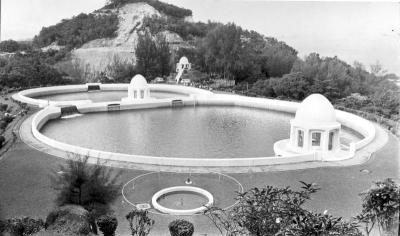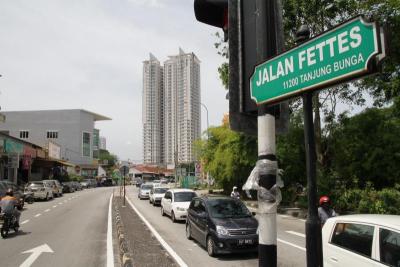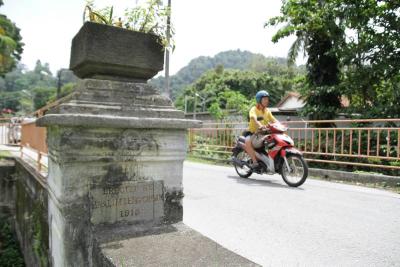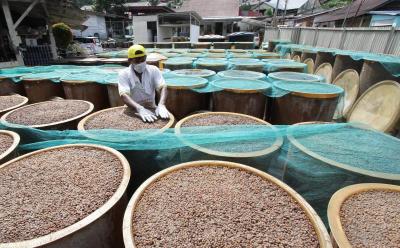 Scenic: A filepic of the Guillemard Reservoir near the Vale of Tempe.
Scenic: A filepic of the Guillemard Reservoir near the Vale of Tempe. CALL it an urban legend but I have heard enough spooky tales about the many unexplained incidents along the Vale of Tempe.
The name of this winding stretch of road is Greek to many Penangites but to the older folks, this is certainly a famous, or more precisely, an infamous road.
Even the origin of the name remains speculative. It must be the only road in Malaysia that is named after a place in Greece.
Located between Olympus to the north and Ossa to the south, the Vale of Tempe is a beautiful gorge nestled in northern Thessaly, Greece.
Quite appropriately, its current Malay name, Jalan Lembah Permai, means peaceful valley.
What is more interesting is that in Greek mythology, the Vale of Tempe was the favourite hunting ground of the god Apollo and the Muses.
The winding 1.7km road cuts across a hill joining two suburbs, Tanjung Bungah and Fettes Park.
A reservoir is built on a hillside in Vale of Tempe, and is named after Sir Laurence Guillemard, who was the Governor of the Crown Colony of the Straits Settlements from 1920 to 1927.
As one report rightly described it, Guillemard Reservoir comprises two equal size ponds with two cupolas. Due to it being shaped like a pair of spectacles, the Guillemard Reservoir became known in Hokkein as bak knia tee meaning spectacle pond.
If there is any similarity between Vale of Tempe in Greece and the one in the northern part of Penang island, it must be the ravine.
 Residential: Fettes Park is named after JD Fettes, an engineer with the then municipal council.
Residential: Fettes Park is named after JD Fettes, an engineer with the then municipal council. In this hilly part of Penang, many mysterious accidents have happened. Some were fatal while other victims escaped with injuries after their vehicles skidded off the road and went down the ravine.
As a crime reporter in 1980, I remember getting a call from the police that an accident had taken place at the Vale of Tempe. It was just 7am and was still too early to start work.
I remember asking my police source if it was a serious accident to warrant such an early call but he merely chuckled and say I should head towards the scene if I wanted an interesting story.
When I arrived at the scene of the accident, I could see the damaged car in the ravine but someone had also lighted some candles and burned some offerings, presumably to appease some powerful forces.
There was no one else at the accident scene who could tell me what had taken place. I then decided to head towards the Penang General Hospital, where most accident victims would be sent to.
Remember these were the days before the mobile telephones and there were just one or two other private hospitals.
I finally located the victim after checking with the nurses at the emergency section. Not wanting to put the victim and his relatives at the ward on guard, I did not introduce myself as a reporter but merely a nosy visitor at the hospital.
The victim, a middle-aged man, was narrating to his relatives that he was driving along the Vale of Tempe around 1am when he saw a woman in white in the middle of the road.
He swore in Hokkien that he wasn’t drunk but the sight of the woman frightened him so much that he lost control of his car.
He was sure it was no ordinary human being but a ghost.
It would be the first time that I have heard stories of unexplained “dirty” encounters at the Vale of Tempe but it was the first involving a victim, if that is a right word to use. There are many variations but they all involved a young woman!
One tale guaranteed to give one the goose pimples was about a young factory male worker. He was driving along the road, when a young woman ended up sitting next to him in the car. As in all the tales, the shocked driver swayed his car and ended up in the ravine!
 Old school: The entrance to Pepper Estate.
Old school: The entrance to Pepper Estate. Many Penangites are reluctant to use the road at night and they would probably advise their family members not to do so either. There are practical reasons too, as the road is not well-lit and the curves are tricky to negotiate.
Last week, on a trip to Penang, I decided to re-visit the Vale of Tempe, to update myself on its condition.
My brother’s daughter, Wong Lai Pheng, uses the road as an access route to reach her apartment at Tanjung Bungah from Mount Erskine. She said the main Tanjung Tokong road is often congested and using the Vale of Tempe was so much easier.
My driver, Praba, from the Penang office has been using the road to send colleagues, who had completed the graveyard shift, pardon the pun, to their homes each night. The young man from Seberang Prai does not even know the name of the road he has been using and stories of a woman in white were news to him!
Ignorance is bliss but after sharing my tales of this urban legend, perhaps more known to other Penangites, I am sure Lai Pheng and Praba will not want to look behind when they are driving alone along that road at night!
Tales from the Vale of Tempe have even made it to www.hungzai.com, a Singapore website of horror stories.
But apart from the horror stories, there were also real events that put the area into the spotlight.
One of the most famous real-life events relate to a murder case in November 1980. Joggers came across a badly decomposed body that had been dumped into the ravine along the road.
The body turned out to be that of factory worker Salbiah Yeop Abdul Rahman and police inspector Saderi Abdul Samat was subsequently sent to the gallows for her murder.
Salbiah was Saderi’s lover and pregnant at the time but the inspector never admitted to killing her, but insisted she had committed suicide. He claimed that he had found Salbiah hanging in the bathroom of the officers’ mess where he lived.
He drove around various parts of Penang to get rid of the body until he came to the Vale of Tempe.
Another story from our library archives related to an incident in 2001 when a skull of young girl was found in the undergrowth off the Vale of Tempe main road.
The skull was discovered by a man picking fruits in the area at about 4.30pm.
He called the police who in turn contacted forensic pathologist Dr Bhupinder Singh. The skull, which had been there for about five months, was wrapped in a pillow case and a piece of cloth which was badly torn. Bits of ribs and pelvic bone plus strands of black hair were also found at the scene.
 Cottage industry: One source of employment in the Hong Seng Estate is a sauce manufacturer.
Cottage industry: One source of employment in the Hong Seng Estate is a sauce manufacturer. According to then George Town OCPD Senior Asst Comm (II) Mustafa Abdullah, the police had yet to determine why the skull, which was that of a girl aged between five and six, had been placed there.
“Somebody could have been trying to bury the skull after using it for ceremonial purposes — perhaps to obtain lottery numbers.
“We have classified the find as sudden death pending a postmortem by Dr Bhupinder. Foul play has also not been ruled out,” he said.
Back to the roads, if you think Vale of Tempe is an unusual name for a road, so too are the nearby Fettes Park and Mount Erskine. Fettes Park is a residential neighbourhood in Tanjung Tokong and is named after the municipal engineer of George Town JD Fettes, who was instrumental in the building of the Guillemard Reservoir.
Mount Erskine or pek hoon sua in Hokkien, or White Cloud Mountain, is a residential area not far from Pulau Tikus and Gurney Drive.
It is named after John James Erskine, a judge and member of the George Town council around 1810, who was known as the “second king of Penang” because of his influence and clout.
The area is known for the large Chinese cemeteries, some dating back from the early 19th century, and during the All Souls Day or Qing Ming Festival, this place is packed.
Not many Penangites are superstitious of the presence of the graves as human beings jostled for space with the dead in Penang. The top of Mount Erskine has now been flattened to make way for apartments.
Even during the 1970s, many homes have been built at the nearby Pepper Estate and Hong Seng Estate, where one has to drive through tombs to reach these houses. Many of these houses are located next to graveyards and no one has any ghostly stories to tell.
There used to be a pepper estate and the settlement built as a living quarters of the estate workers. A former school mate and close friend, Loy Boon Peow, grew up in Hong Seng Estate.
Certainly, these tales have made the area more interesting but as Penang becomes more crowded, the roads will become busier and congested.
The isolation is gone and so would the mysterious atmosphere.
Readers write
REFERRING to your article on June 15 about Anson Road, specifically on Tai Hin coffeeshop.
It was November 1967, when I was in Form 4, that I went camping with a brother scout in the Methodist Boys’ School grounds for one of our Scout achievement badges towards the award of King Scout certification.
The campsite was behind the dilapidated Suffolk House and by the Ayer Itam riverbank.
We had camped one night when the next day my parents came looking for me to take me home as the Hartal (the general strike in protest against the proposed Federation of Malaya) troubles had started in George Town and were racial in nature.
So we decided to quickly pack up and leave and send my friend back to his house in Anson Road on our way back to our house in Leith Street Ghaut.
We had to get my Chinese friend to lie down on the floor of our car as we had to pass through the kampung area by the bridge, in Ayer Itam Road.
There were already groups of villagers from Langkawi Road gathered on the bridge. Luckily we were not stopped and proceeded very quickly to Anson Road to send my friend to the Tai Hin coffee shop where he lived.
We also did not encounter any trouble in the Anson Road area, which was a Chinese area.
Thank God we arrived safely in our house before the curfew came into force.
— Syed Kamarulzaman Syed Kabeer





